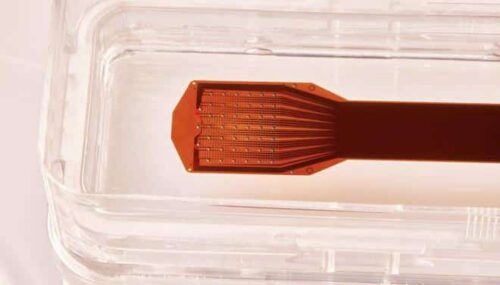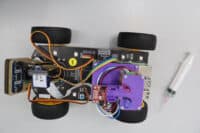Precision, co-founded by Michael Mager and Benjamin Rapoport, two other co-founders of Musk’s brain-computer interface company Neuralink, also announced a new Series B funding round of more than $40 million this week.
The human cerebral cortex is composed of six cell layers. The work done by Precision scientists and engineers is to artificially construct a “seventh layer” cortical interface on the surface of the six layers of cells, and implant it into the brain in a “semi-invasive” way . The company says this means that patients with severe degenerative diseases such as ALS will regain the ability to communicate with the outside world by moving a cursor, typing or even using their thoughts to access social media.
Similar to companies currently engaged in the research and development of brain-computer interface devices on the market, the “seventh layer” device developed by Precision is essentially a flexible electrode array, but it is characterized by ultra-thin, only five times the thickness of a hair One, it is not easy to damage the brain tissue after being attached to the surface of the brain.
This semi-invasive implant sits somewhere between a deep brain implant and an external brain stimulation device. The advantage is that it can reduce the damage to the brain caused by invasive surgery (the surgical wound is less than 1 mm), and the accuracy of brain signal extraction is higher than that of externally connected devices; but the disadvantage is that since the device is attached to the surface of the brain, it can The processed brain signals are limited to the cerebral cortex signals, and cannot extract the signals deep in the brain that control memory, emotion and other advanced cognition.
According to the company, Precision has successfully decoded neural signals in animals using a “layer seven” device and is expected to receive FDA approval to test the technology on humans within the next few months.
Song Enming, a researcher at the Institute of Optoelectronics of Fudan University, said in a telephone interview with a reporter from China Business News on January 28: “The advantages of this type of semi-invasive brain-computer interface products are reflected in the ultra-thin flexible structure and the safety of minimally invasive surgery. , its EEG signal processing ability also benefits from breakthroughs in high-precision technology and material science. However, any device implanted in the brain will face huge ethical challenges, and the brain of the biological body is vulnerable to potential hazards from product leakage currents, so Both safety and efficacy need to be further verified.”
When talking about the technical challenges faced by flexible brain-computer interface products, Song Enming told the first financial reporter: “The ideal flexible material should have two characteristics. One is ultra-thin and soft, which can avoid damage to fragile brain tissue. The second is to have stable performance, which can prevent the penetration of cerebrospinal fluid and the slippage that is easy to occur after material implantation.”
Song Enming introduced to the first financial reporter that at present, most of the implantable flexible electrodes developed by brain-computer interface companies are made of metal conductors such as gold or platinum, and the corresponding flexible electronic packages are prone to leakage problems, which poses risks in terms of application safety. , and the signal-to-noise ratio is low in EEG signal acquisition. Song Enming’s team proposed a high-throughput brain-computer interface flexible electrode with an integrated silicon-based transistor array, which is expected to achieve longer-term EEG signal recording.
“The microelectrode array of the implantable brain-computer interface can make EEG sensing with high spatiotemporal precision possible, and large-scale silicon thin-film transistors can realize high-density EEG signal amplification.” Song Enming told the first financial reporter. He also said that the team is working on a silicon-based degradable brain-computer interface system with better biocompatibility to optimize the signal-to-noise ratio of the brain-computer interface and solve the risk of secondary surgery caused by implant failure.




GIPHY App Key not set. Please check settings